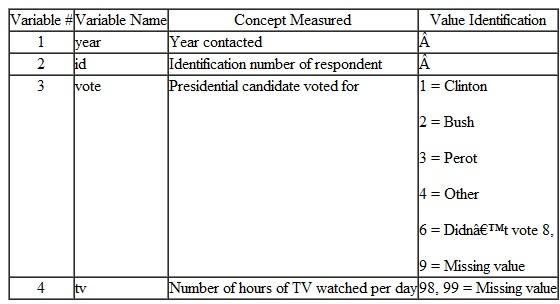
A Visual Approach to SPSS for Windows 2nd Edition by Leonard Stern
Edition 2ISBN: 978-0205706051
A Visual Approach to SPSS for Windows 2nd Edition by Leonard Stern
Edition 2ISBN: 978-0205706051 Exercise 2
The data in the file voteTV.sav provided on the publisher's website for this text at http://www.pearsonhighered.com/stern2e, show how randomly selected adults aged 18-65 who were contacted by the National Opinion Research Center between 1993-1998 report they voted in the 1992 presidential election. The candidates running for president of the U.S. were Republican George H.W. Bush, Democrat Bill Clinton, and Independent Ross Perot. The table shown below describes the variables and their values contained in the data file.
 1. Assume a researcher planned to investigate whether people who voted for Clinton watched a different number of hours of TV per day than those who voted for Bush and Perot, and that those who voted for Bush and Perot watched a comparable number of hours of TV per day. Conduct suitable analyses to address these questions. (Hint: use the comparison coefficients -2 1 1 to answer the first question and the coefficients 0 -1 1 to answer the second question. Be sure to select the data of only participants who voted for one of the 3 candidates.)
1. Assume a researcher planned to investigate whether people who voted for Clinton watched a different number of hours of TV per day than those who voted for Bush and Perot, and that those who voted for Bush and Perot watched a comparable number of hours of TV per day. Conduct suitable analyses to address these questions. (Hint: use the comparison coefficients -2 1 1 to answer the first question and the coefficients 0 -1 1 to answer the second question. Be sure to select the data of only participants who voted for one of the 3 candidates.)
2. Assume a researcher planned to investigate whether the combination of people who voted for Clinton, Bush, or Perot watched a different number of hours of TV per day than the combination of those who voted for some other candidate or didn't vote. Conduct a suitable analysis to answer this question.
 1. Assume a researcher planned to investigate whether people who voted for Clinton watched a different number of hours of TV per day than those who voted for Bush and Perot, and that those who voted for Bush and Perot watched a comparable number of hours of TV per day. Conduct suitable analyses to address these questions. (Hint: use the comparison coefficients -2 1 1 to answer the first question and the coefficients 0 -1 1 to answer the second question. Be sure to select the data of only participants who voted for one of the 3 candidates.)
1. Assume a researcher planned to investigate whether people who voted for Clinton watched a different number of hours of TV per day than those who voted for Bush and Perot, and that those who voted for Bush and Perot watched a comparable number of hours of TV per day. Conduct suitable analyses to address these questions. (Hint: use the comparison coefficients -2 1 1 to answer the first question and the coefficients 0 -1 1 to answer the second question. Be sure to select the data of only participants who voted for one of the 3 candidates.)2. Assume a researcher planned to investigate whether the combination of people who voted for Clinton, Bush, or Perot watched a different number of hours of TV per day than the combination of those who voted for some other candidate or didn't vote. Conduct a suitable analysis to answer this question.
Explanation

This question doesn’t have an expert verified answer yet, let Quizplus AI Copilot help.
A Visual Approach to SPSS for Windows 2nd Edition by Leonard Stern
Why don’t you like this exercise?
Other Minimum 8 character and maximum 255 character
Character 255



